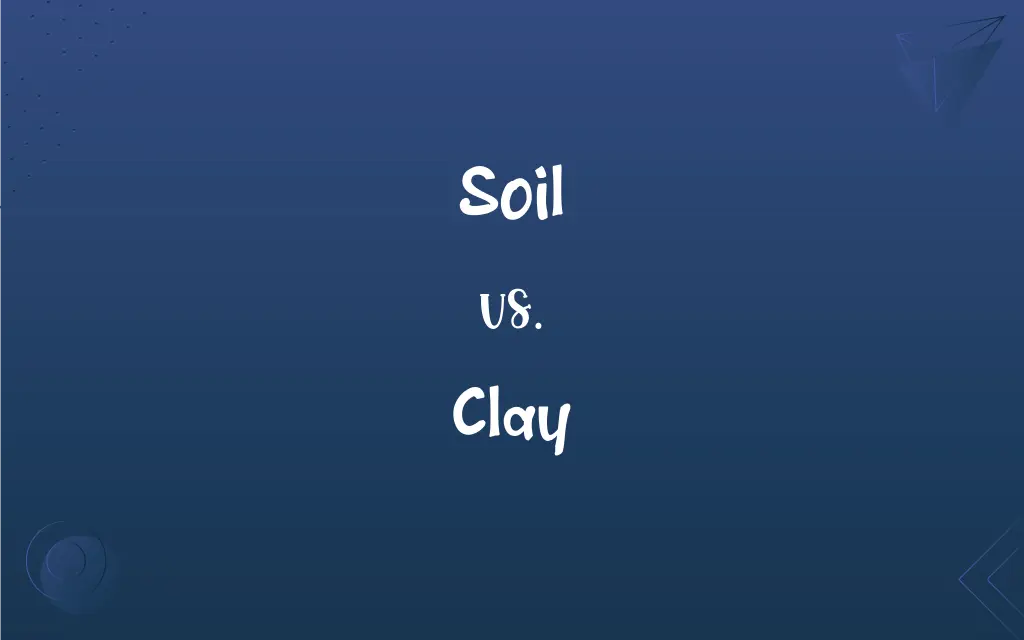Soil vs. Clay: What's the Difference?
Edited by Harlon Moss || By Janet White || Updated on June 21, 2024
Soil is a complex mixture of organic matter, minerals, gases, and water, supporting plant life. Clay, a component of soil, is a fine-grained natural earth material that becomes plastic when wet.

Key Differences
Soil is a natural body comprised of solids (minerals and organic matter), liquid, and gases. It varies widely in composition based on factors like climate, organisms, and time. In contrast, clay is a specific type of soil component characterized by its fine particles and plasticity when moist. It’s primarily composed of various minerals, including alumina, silica, and water.
The texture of soil depends on the proportions of its components, including sand, silt, and clay. Soil with a high clay content is known as clay soil. Pure clay, however, is solely made up of fine particles that are less than 0.002 mm in diameter. This fine texture gives clay a smooth, sticky feel when wet and allows it to be molded and shaped.
Soil's ability to retain water varies based on its composition. Soils with higher clay content generally have better water retention due to the small size of clay particles. On the other hand, clay itself can retain a significant amount of water, which leads to less air space and poor drainage when used alone.
Soil, in its various forms, is essential for agriculture, providing the necessary nutrients and support for plant growth. Clay, due to its plasticity and ability to hold shape when dried, is extensively used in pottery, brick-making, and construction materials.
Soil forms through the weathering of rocks and organic matter over long periods. Clay can be a product of this weathering process, forming from the decomposition of silicate-bearing rocks. The process of soil and clay formation is influenced by environmental factors like weather, topography, and biological activity.
ADVERTISEMENT
Comparison Chart
Texture
Varies from sandy to loamy
Fine-grained and smooth
Particle Size
Ranges from coarse to fine
Extremely fine, less than 0.002 mm
Plasticity
Generally non-plastic
Becomes plastic when wet
Water Retention
Varies based on composition
High water retention
Primary Use
Agriculture, gardening
Pottery, construction
ADVERTISEMENT
Soil and Clay Definitions
Soil
Soil is the upper layer of earth in which plants grow.
A healthy soil is crucial for gardening.
Clay
Clay is a soil type known for its ability to retain moisture and nutrients.
Clay soils are challenging for drainage.
Soil
Soil refers to the material on the surface of the earth in which terrestrial plants grow.
The soil in this area is rich and fertile.
Clay
Clay refers to a sticky form of soil typically used in pottery and ceramics.
The potter spun the clay on the wheel expertly.
Soil
Soil is a mixture of organic matter, minerals, and nutrients that supports life.
The farmer tested the soil for its nutrient content.
Clay
Clay is a fine-grained natural earth material that is pliable when wet.
She molded a vase out of wet clay.
Soil
Soil is the loose surface material of the earth where plants establish their roots.
Soil erosion can be a significant environmental issue.
Clay
Clay is a natural, earthy material composed of fine-grained minerals.
Bricks are often made from fired clay.
Soil
Soil encompasses the variety of earth’s land surfaces, providing a medium for plant roots.
Different plants require different types of soil.
Clay
Clay, as a soil component, influences the soil's texture and fertility.
Adding sand to clay can improve its texture for planting.
Soil
The top layer of the earth's surface in which plants can grow, consisting of rock and mineral particles mixed with decayed organic matter and having the capability of retaining water.
Clay
A fine-grained, firm earthy material that is plastic when wet and hardens when heated, consisting primarily of hydrated silicates of aluminum and widely used in making bricks, tiles, and pottery.
Soil
A particular kind of earth or ground
Sandy soil.
Clay
A hardening or nonhardening material having a consistency similar to clay and used for modeling.
FAQs
What is soil?
Soil is the top layer of the earth's crust, supporting plant life.
What are the uses of clay?
Clay is used in pottery, construction, and as a soil amendment.
What defines soil texture?
Soil texture is defined by the size of its particles: sand, silt, and clay.
How is clay formed?
Clay forms from the weathering of silicate-bearing rocks.
What is clay?
Clay is a fine-grained natural earth material, pliable when wet.
How does soil composition vary?
Soil composition varies with mineral, organic content, and climate.
How does clay affect soil drainage?
Clay in soil can hinder drainage due to its fine particles.
What's the difference between soil and dirt?
Soil is alive with organisms; dirt is displaced soil.
Are there different types of clay?
Yes, including kaolin, bentonite, and ball clay.
Is clay only used for pottery?
No, it's also used in construction and as a soil amendment.
What role does soil play in agriculture?
Soil provides nutrients and support for plant growth.
How does soil support ecosystems?
Soil supports ecosystems by providing nutrients and water.
Is all clay suitable for pottery?
Not all clay types are ideal for pottery due to different properties.
What is soil erosion?
Soil erosion is the displacement of the topsoil layer.
Why is clay important in construction?
Clay's plasticity and durability make it suitable for construction materials.
Can soil be contaminated?
Yes, soil can be contaminated by chemicals and pollutants.
Can soil be artificially created?
Yes, through mixing organic and inorganic materials.
How does soil affect plant growth?
Soil quality influences water, nutrient availability, and root development.
How is clay extracted?
Clay is usually extracted from quarries or pits.
Can clay be found in all soil types?
Clay is a common component but varies in concentration.
About Author
Written by
Janet WhiteJanet White has been an esteemed writer and blogger for Difference Wiki. Holding a Master's degree in Science and Medical Journalism from the prestigious Boston University, she has consistently demonstrated her expertise and passion for her field. When she's not immersed in her work, Janet relishes her time exercising, delving into a good book, and cherishing moments with friends and family.
Edited by
Harlon MossHarlon is a seasoned quality moderator and accomplished content writer for Difference Wiki. An alumnus of the prestigious University of California, he earned his degree in Computer Science. Leveraging his academic background, Harlon brings a meticulous and informed perspective to his work, ensuring content accuracy and excellence.

































































